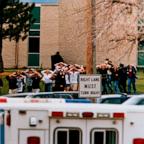Deaths of Granite Mountain Hotshots Expose Fight Over Airtankers
Ariz. probe finds one airtanker over fire as rescuers searched for lost crew.
Sept. 30, 2013 <br>WASHINGTON -- The tragedy of the Granite Mountain Hotshots has renewed attention to the dwindling federal resources to fight a growing number of forest fires, even though an independent investigation found no one to blame in the deaths of 19 Arizona wildland firefighters last June.
It will never be known if greater availability of large airtankers contracted by the U.S. Forest Service would have saved their lives, but the tragedy put on public display a system where incident commanders overseeing even large fires have to beg for planes to drop retardant.
When the commanders in Yarnell, Ariz. asked for six large airtankers to drop retardant onto the fire from the afternoon into evening -- the period when it then intensified and swept over the hotshots -- the federal response was, "Unable to fill at this time."
After months of speculation about how the hotshot crew got killed in the Yarnell mountain blaze on June 30, a multi-agency investigation reported on Saturday that the elite team simply ran out of luck in the face of extraordinary forces of nature.
Nobody screwed up, the independent investigation concluded.
"The team found no indication of negligence, reckless actions, or violations of policy or protocol" by the wildland firefighters or their on-scene supervisors, the report said.
The firefighters' deaths in 2,000-degree heat was a horrifying tragedy with nothing to blame but the weather and no one to hold liable -- known as an "act of God" in the law.
An ABC News investigation this month found that even as wildfires have been getting worse over the past decade of drought in the western U.S., the U.S. Forest Service fleet of large airtankers that drop retardant has shrunk 75 percent without any approved plan for replacing aged aircraft that have crashed, been grounded or plagued with mechanical problems.
The Arizona investigators found that most of the Forest Service's Korean War-vintage fleet of nine "large airtankers" were summoned by state officials that afternoon to drop retardant around the tiny town of Yarnell, but were denied by the federally-operated National Interagency Coordination Center.
Demand from other fires throughout the West was too high for all but one of the half-dozen Forest Service planes state officials requested to continue dropping retardant beyond the morning on the growing Yarnell fire 30 miles south of Prescott.
And, as first reported by ABC News, the investigation team found that the lone plane flying toward Yarnell as the hotshots called for help – Tanker 43, a P2V retired sub hunter owned by Neptune Aviation – suddenly "suffered a left reciprocal piston engine mechanical failure that forced them to jettison their retardant load and return to the base of departure."
Arizona Forestry Division spokesman Jim Paxon and Prescott Fire Wildland Division Chief Darryl Willis, who oversaw the Granite Mountain Hotshots, told ABC News in July that they believed the 1950s era airtanker might have helped save the crew had it arrived in Yarnell.
The fire was unusual in that it suddenly changed direction around 4:30 pm, with 50 mph winds shooting 70-foot flames horizontally across Yarnell Hill driven and racing across the ground faster than a man could outrun it.




